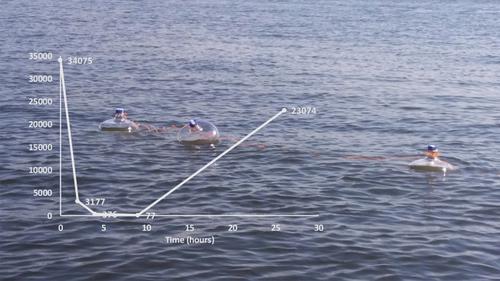当前位置:
X-MOL 学术
›
Curr. Microbiol.
›
论文详情
Our official English website, www.x-mol.net, welcomes your feedback! (Note: you will need to create a separate account there.)
Escherichia coli Capacity to Repopulate Microcosms Under Osmotic/U.V. Synergic Stress in Tropical Waters
Current Microbiology ( IF 2.6 ) Pub Date : 2021-01-19 , DOI: 10.1007/s00284-020-02319-2 Marcos T. Carneiro , Daniel V. Perez , Renato C. Feitosa , Lorena G. P. Macena , Marize P. Miagostovich , Julio C. Wasserman
Current Microbiology ( IF 2.6 ) Pub Date : 2021-01-19 , DOI: 10.1007/s00284-020-02319-2 Marcos T. Carneiro , Daniel V. Perez , Renato C. Feitosa , Lorena G. P. Macena , Marize P. Miagostovich , Julio C. Wasserman

|
Abstract In both Brazilian and European regulations, the impact assessment of sewage discharges into coastal waters is based on microbiological analyses of fecal indicators such as Escherichia coli , frequently used in prevision hydrodynamic models. However, the decay rates of E. coli vary depending on environmental conditions, and analysis may lead to inaccurate conclusions. This study aimed to analyze the decay of culturable and viable (but not culturable) E. coli in outdoor conditions, by creating microcosms inoculated with pre-treated sewage. The microcosms were filled with 9.88 L of filtered water (0.22 μm membrane), 3.5% salt, 0.1–0.2% BHI, and 1% bacterial suspension obtained by reverse filtration. PMA-qPCR of E. coli uidA gene and Colilert measurements were applied to evaluate population counts after 2 h, 4 h, and 26 h. After nine hours of exposure to solar radiation, the viable cells decreased to 2.76% (interpolated value) of the initial population, and the cultivable fraction of the viable population accounted for 0.50%. In the dark period, the bacteria grew again, and viable cells reached 8.54%, while cultivable cells grew to 48.14% of initial population. This behavior is possibly due to the use of nutrients recycled from dead cells. Likewise, populations of E. coli in sewage outfalls remain viable in the sediments, where resuspension can renew blooming. Graphic Abstract
中文翻译:

大肠杆菌在热带水域渗透/紫外线协同胁迫下重新繁殖微观世界的能力
摘要 在巴西和欧洲的法规中,对沿海水域排放污水的影响评估是基于粪便指标(如大肠杆菌)的微生物分析,常用于预测水动力模型。然而,大肠杆菌的衰减率因环境条件而异,分析可能会导致不准确的结论。本研究旨在通过创建接种预处理污水的微观世界,分析室外条件下可培养和可存活(但不可培养)大肠杆菌的腐烂情况。微观世界充满了 9.88 L 过滤水(0.22 μm 膜)、3.5% 盐、0.1-0.2% BHI 和 1% 通过反向过滤获得的细菌悬浮液。应用大肠杆菌 uidA 基因的 PMA-qPCR 和 Colilert 测量来评估 2 小时、4 小时和 26 小时后的种群计数。暴露于太阳辐射9小时后,活细胞减少到初始种群的2.76%(内插值),活种群的可培养部分占0.50%。在黑暗时期,细菌再次生长,活细胞达到8.54%,而可培养细胞增长到初始种群的48.14%。这种行为可能是由于使用了从死细胞中回收的营养物质。同样,排污口中的大肠杆菌种群在沉积物中仍然存活,在沉积物中重新悬浮可以重新开花。图形摘要 而可培养细胞增长到初始种群的 48.14%。这种行为可能是由于使用了从死细胞中回收的营养物质。同样,排污口中的大肠杆菌种群在沉积物中仍然存活,在沉积物中重新悬浮可以重新开花。图形摘要 而可培养细胞增长到初始种群的 48.14%。这种行为可能是由于使用了从死细胞中回收的营养物质。同样,排污口中的大肠杆菌种群在沉积物中仍然存活,在沉积物中重新悬浮可以重新开花。图形摘要
更新日期:2021-01-19
中文翻译:

大肠杆菌在热带水域渗透/紫外线协同胁迫下重新繁殖微观世界的能力
摘要 在巴西和欧洲的法规中,对沿海水域排放污水的影响评估是基于粪便指标(如大肠杆菌)的微生物分析,常用于预测水动力模型。然而,大肠杆菌的衰减率因环境条件而异,分析可能会导致不准确的结论。本研究旨在通过创建接种预处理污水的微观世界,分析室外条件下可培养和可存活(但不可培养)大肠杆菌的腐烂情况。微观世界充满了 9.88 L 过滤水(0.22 μm 膜)、3.5% 盐、0.1-0.2% BHI 和 1% 通过反向过滤获得的细菌悬浮液。应用大肠杆菌 uidA 基因的 PMA-qPCR 和 Colilert 测量来评估 2 小时、4 小时和 26 小时后的种群计数。暴露于太阳辐射9小时后,活细胞减少到初始种群的2.76%(内插值),活种群的可培养部分占0.50%。在黑暗时期,细菌再次生长,活细胞达到8.54%,而可培养细胞增长到初始种群的48.14%。这种行为可能是由于使用了从死细胞中回收的营养物质。同样,排污口中的大肠杆菌种群在沉积物中仍然存活,在沉积物中重新悬浮可以重新开花。图形摘要 而可培养细胞增长到初始种群的 48.14%。这种行为可能是由于使用了从死细胞中回收的营养物质。同样,排污口中的大肠杆菌种群在沉积物中仍然存活,在沉积物中重新悬浮可以重新开花。图形摘要 而可培养细胞增长到初始种群的 48.14%。这种行为可能是由于使用了从死细胞中回收的营养物质。同样,排污口中的大肠杆菌种群在沉积物中仍然存活,在沉积物中重新悬浮可以重新开花。图形摘要



























 京公网安备 11010802027423号
京公网安备 11010802027423号